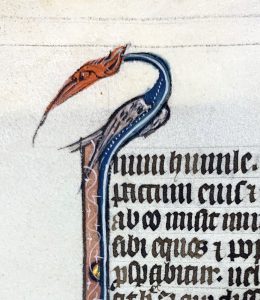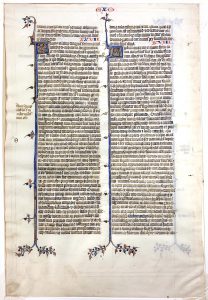Two Old Testament Leaves from ‘Otto Ege Manuscript 14’ at Smith College
March 11, 2022 in Manuscript Studies
Two Leaves
from ‘Otto Ege Manuscript 14’
at Smith College

Smith College Special Collections, MS 36-6, verso, top left, from ‘Otto Ege MS 14’. Photography by Hannah Goeselt.
Large-format Latin Vulgate Lectern Bible
made in France
late 13th- or early 14th century
Single Leaf within a matted frame
Double columns of 50 lines
Exodus 25:31 (procedentia) – 28:21 (cela-[/buntur singuli])
with Ege Label
and
Ezekiel 16:43 ([irascar amplius /] eo quod) – 17:14 (sic reg/-num humile et])
[Posted on 12 March 2022.]
We warmly thank Hannah Goeselt, responding to our blogposts, for sending information and images for parts of ‘Otto Ege Manuscript 14’ at Smith College, Northampton, Massachusetts. The ‘moniker’ for the manuscript derives from the decisive impact upon it effected by Otto F. Ege (1888–1951) and the place-number which its selected specimen leaves occupied in his monumental Portfolio of Fifty Original Leaves from Medieval Manuscripts, Western Europe, XIII–XVI Century, issued in forty numbered sets. Ege assigned the date of “1300 A. D.” to the Bible and its specimens.

Smith College Special Collections, MS 35-14, verso, from ‘Otto Ege MS 14’. Photography by Hannah Goeselt.
Discoveries for other parts of this dismembered and dispersed manuscript, a large-format Lectern Bible in the Latin Vulgate Version in Gothic Script, with historiated and decorated elements, have been reported in our blog.
- A New Leaf from ‘Otto Ege Manuscript 14’
- More Discoveries for ‘Otto Ege Manuscript 14’
- A Leaf from ‘Otto Ege Manuscript 19’ and Ege’s Workshop Practices
- Updates for Some ‘Otto Ege Manuscripts’ (Ege MSS 8, 14, 41, and 61)
- Some Leaves in Set 1 of ‘Ege’s FOL Portfolio’ (Ege MSS 8, 14, 19, and 41)
- Patch Work in ‘Otto Ege Manuscript 14’
- A Leaf in Dallas from ‘Otto Ege Manuscript 14’.
- A Leaf of Deuteronomy from ‘Otto Ege Manuscript 14’ in the Rosenbrook Collection
See also The Illustrated Handlist (Number 4).
The Smith College Leaves comprise two separate single leaves respectively from the Books of Exodus and Ezekiel. At least one retains the standard printed Ege Label, albeit displaced and rearranged.
The pair augment understanding of the original state of those Biblical Books in the manuscript, and also of habits in the transmission of leaves from it as they were prepared for distribution from Ege’s collection and accommodated in their next collection, where they remain. That their chain of transmission revolves around Mrs. Otto Ege — Louise Hedwig Lange Ege, an alumna of Smith College, and an active partner in the distribution of materials from the Ege Collection both during and after her husband’s lifetime — infuses the presence of these and other Ege leaves at her alma mater.
